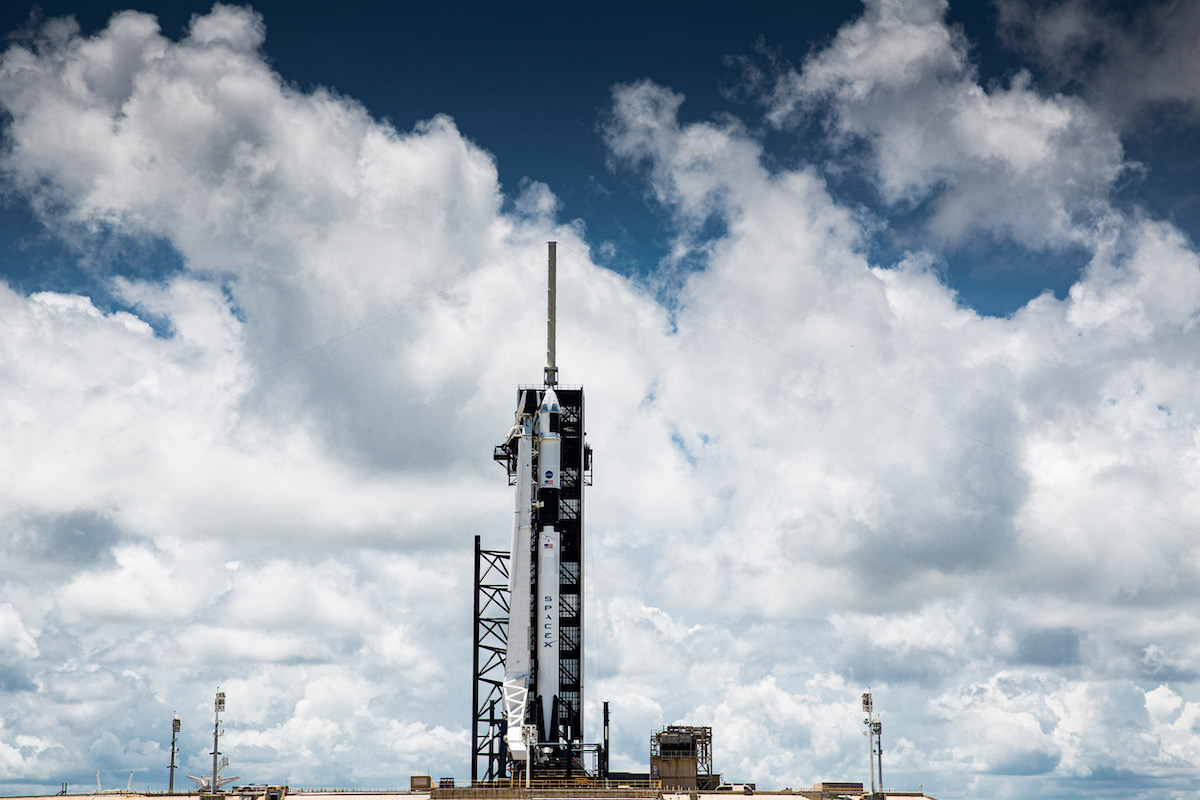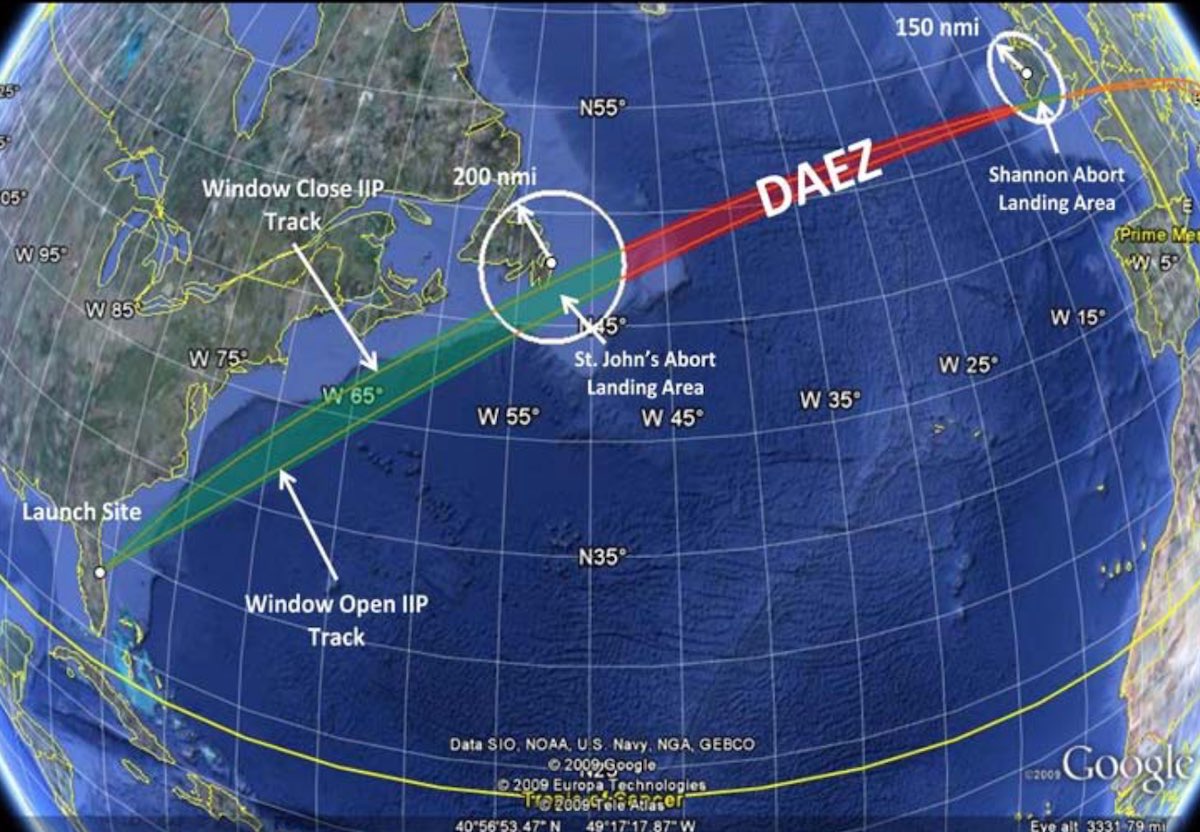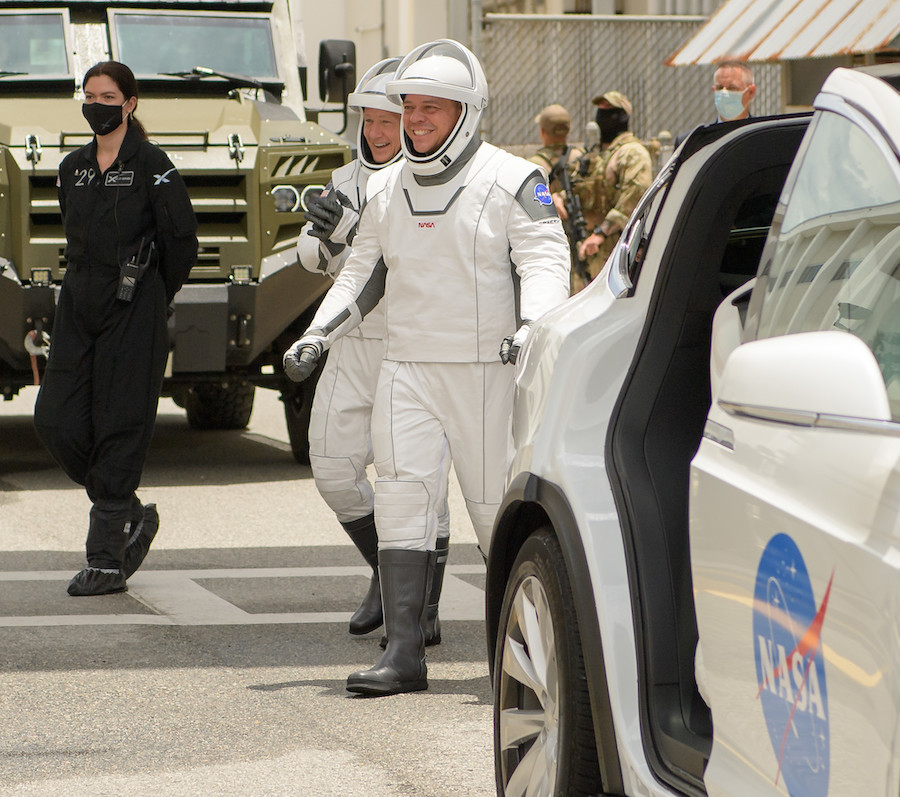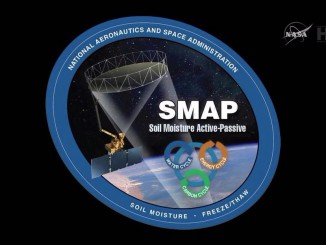
Mission managers are weighing a motley mix of weather models, safety criteria and astronaut workload considerations as they decide when SpaceX’s Crew Dragon spacecraft might have the best chance to launch from the Kennedy Space Center.
The launch could occur as soon as Saturday, when the Crew Dragon’s first piloted test flight has an opportunity to lift off from pad 39A at 3:22:45 p.m. EDT (1922:45 GMT). Each day’s launch time is determined by when the Earth’s rotation brings pad 39A under the orbital ground track of the International Space Station, the mission’s destination.
Launch opportunities move around 22-to-23 minutes earlier each day.
NASA astronauts Doug Hurley and Bob Behnken will ride into orbit on the Crew Dragon spacecraft atop SpaceX’s Falcon 9 rocket. The launch will mark the first crewed flight into orbit from U.S. soil since the space shuttle was retired in 2011.
There are 50/50 odds of acceptable weather for launch of the Crew Dragon spacecraft Saturday, according to the U.S. Space Force’s 45th Weather Squadron. Slightly better weather is in the forecast Sunday, when there’s a 60 percent chance of favorable conditions for liftoff at 3 p.m. EDT (1900 GMT).
SpaceX and NASA officials completed a “delta” Launch Readiness Review on Friday and determined the Falcon 9 rocket, Crew Dragon capsule and ground systems were ready for another launch attempt Saturday.
But officials planned to meet again Saturday morning before go ahead with further launch preparations, such as having the astronauts put on their flight suits and head to the launch pad.
“Teams still want more weather data to determine if they will proceed with a launch attempt (Saturday) or focus on the backup attempt on Sunday, May 31,” NASA said in an update posted online late Friday.
Forecasters expect a drier weather pattern next week, potentially leading to more favorable conditions for launch.
“We’re actually looking a little further out, and the weather is starting to improve early next week,” said Capt. Jason Fontenot, Space Lift Weather Operations Flight Commander at the 45th Weather Squadron, which provides forecast services for launch companies operating at Cape Canaveral.
If the Crew Dragon takes off Saturday, the capsule would link up with the space station at 10:29 a.m. EDT (1429 GMT) Sunday. A launch Sunday would result in a docking with the space station around 10 a.m. EDT (1400 GMT) Monday.
Not only will officials consider the weather at the launch site — such as lightning, winds, cloud cover and precipitation — mission managers will also assess conditions at more than 50 locations in the Atlantic Ocean downrange from the Kennedy Space Center.
Officials want to ensure ground winds and sea states are within limits in case the Crew Dragon spacecraft has to perform an escape maneuver during launch. The escape burn would push the capsule off its Falcon 9 launcher in the event of an in-flight failure, resulting in the splashdown of the spacecraft and its crew along the mission’s downrange corridor heading northeast from Cape Canaveral along the East Coast of the United States and Canada.
There’s also an option for the Crew Dragon to abort and splash down off the coast of Ireland, and officials will monitor weather conditions all along the trajectory.
In a teleconference with reporters Friday, Fontenot said the weather at the downrange abort locations appear “fairly favorable” this weekend. But that could change based on real-time measurements from buoys in the Atlantic Ocean.
“We have a really complicated way of weighting different locations, depending on how much risk they have in terms of an escape,” said Hans Koenigsmann, SpaceX’s vice president of build and flight reliability. “For the landing, there are also special parameters: winds, waves and wave direction.
“Some of these individually have to go ‘green’ and be a ‘go,’ and then on the entire launch corridor we have a common risk number that we use to basically make an assessment, and then get to a go/no go decision,” Koenigsmann said in a press conference Monday.
SpaceX also would like to have good weather for landing of the Falcon 9 rocket’s first stage booster after the Crew Dragon launch. The booster will target a touchdown on a drone ship several hundred miles northeast of the Kennedy Space Center, allowing SpaceX to recover and reuse the vehicle.
“When we balance all of these things, there is always, always, always going to be uncertainty,” Bridenstine said.

If winds are blowing from the east, officials will have to ensure the gusts are not strong enough to blow the Crew Dragon back on land if it has to activate its escape engines before liftoff. In that event, the capsule is supposed to propel itself off the rocket and parachute into the Atlantic just offshore.
“When you talk about launching to the International Space Station, your launch window is not a window at all,” Bridenstine said. “It’s instantaneous and if you don’t meet it, you don’t go. So you have to have all these things met ahead of time.”
NASA officials prefer to launch the Crew Dragon spacecraft on a course that would enable the capsule to dock with the space station less than 24 hours after liftoff — a scenario known as a Flight Day 2 rendezvous. But that’s feasible with only some launch opportunities, when the space station’s location in its orbit at the time of the Dragon’s launch makes for a shorter trip.
The Crew Dragon’s next launch opportunity after Sunday would be Tuesday, June 2. A launch on that day would result in a Flight Day 3 rendezvous, and NASA officials said they would carefully evaluate the weather forecast for subsequent days before proceeding with a launch attempt resulting in a Flight Day 3 rendezvous with the space station.
“If the time to (the space station) is 15-to-20 hours, that’s kind of the sweet spot because they can get on orbit, they can get some rest, and then they can dock with the International Space Station,” Bridenstine said.
Nevertheless, SpaceX has requested a backup launch date Tuesday to protect that opportunity, NASA said.
Bridenstine said NASA and SpaceX will also look at whether it’s smart to try to launch on two consecutive days.
“We have to start considering the human factors of that,” he said. “The human factors end up adding some risk as well because it wears everybody out, including our astronauts, although they never complain. We want to make sure that everyone is well-rested and ready to go.”
Here is a list of upcoming launch opportunities for the Crew Dragon Demo-2 mission:
- Saturday, May 30: 3:22 p.m. EDT (1922 GMT)
- Sunday, May 31: 3:00 p.m. EDT (1900 GMT)
- Tuesday, June 2: 2:13 p.m. EDT (1813 GMT) — Flight Day 3 rendezvous
- Wednesday, June 3: 1:48 p.m. EDT (1748 GMT)
- Thursday, June 4: 1:25 p.m. EDT (1725 GMT)
- Saturday, June 6: 12:40 p.m. EDT (1640 GMT) — Flight Day 3 rendezvous
- Sunday, June 7: 12:14 p.m. EDT (1614 GMT)
- Monday, June 8: 11:52 a.m. EDT (1552 GMT)
An initial launch attempt for the Crew Dragon’s Demo-2 test flight Wednesday was scrubbed by the threat of lightning less than 20 minutes before the appointed launch time.
“Our highest priority is, and always has been, Bob and Doug,” said NASA Administrator Jim Bridenstine in a press conference Friday. “Of course, a couple of days ago, we had too much electricity in the atmosphere..”

President Donald Trump and Vice President Mike Pence were at the Kennedy Space Center for Wednesday’s launch attempt. They both plan to return to the Florida spaceport if mission managers decide to press ahead with a launch attempt Saturday.
Bridenstine said the visits from Trump and Pence has not added any pressure to launch the Demo-2 mission.
“We have all been in agreement that there will be no pressure,” Bridenstine said Friday. “We will launch when we are ready … When we do this again Saturday, if we do it again Sunday, we will feel no pressure. We will go when we are ready. Safety is our highest priority.”
On Wednesday’s launch attempt, SpaceX’s launch team strapped Hurley and Behnken into the Crew Dragon spacecraft, closed the hatch, and began fueling the Falcon 9 rocket with super-chilled kerosene and liquid oxygen. It was the first time astronauts were aboard the spacecraft during fueling of the launch vehicle.
The crew also armed the Dragon’s launch abort system, which would use the ship’s SuperDraco rocket engines to propel away from the Falcon 9 rocket in the event an emergency during fueling, or during the climb into orbit.
“We had done a dry dress rehearsal. We had never done a wet dress rehearsal, so getting from position of fueling the rocket and arming the launch abort system and these kind of things that we went through, and then de-fueling … there were learning opportunities there,” Bridenstine said. “We’re always gathering data. The rocket was ready to go, the crew capsule was ready to go, all the ground systems were working according to plan.”
Watch this video recorded earlier as Hurley and Behnken climbed through the hatch of Crew Dragon: https://t.co/1DF5tRjUzj pic.twitter.com/9cjWZPAl40
— Spaceflight Now (@SpaceflightNow) May 27, 2020
SpaceX developed the Crew Dragon capsule in partnership with NASA, which has cinched a series of contracts with SpaceX valued at more than $3.1 billion since 2011. NASA directed the funding to pay SpaceX to design, build and test the Crew Dragon, then perform a series of six operational crew rotation missions to the space station.
Those crew rotation flights — each carrying four astronauts — will begin later this year, assuming a smooth test flight by Hurley and Behnken. They will spend one-to-four months at the space station before returning to Earth for a parachute-assisted splashdown in the Atlantic Ocean east of Florida to conclude the Crew Dragon test flight.
NASA has signed a similar set of crew capsule contracts with Boeing, which aims to fly astronauts for the first time next year. The first unpiloted test flight of Boeing’s Starliner capsule faltered before docking with the space station in December, prompting Boeing and NASA to agree to stage a second uncrewed demonstration flight later this year.
Email the author.
Follow Stephen Clark on Twitter: @StephenClark1.



